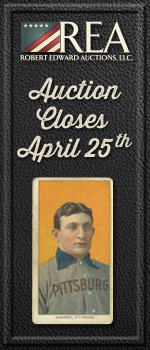As seen from the table, the backs of the first two player-card series (1946-47) provided a brief player profile. For the last two series (1949-50), the bio profile was replaced with summary player statistics for the previous year. While keeping the same basic front design, the final two series (1949-50) added a narrow white border around the player image.
According to Bay Area collector and dealer Mark Macrae, "literally millions of Remar cards were printed and distributed throughout the East Bay area. Cards could be obtained by visiting the corner market and new players were added weekly. Stacks of cards were dropped off daily by the bread drivers and placed near the checkout counter and sometimes stacked near the bread itself. There was never a cost to them, nor was any purchase required. People were encouraged to take as many as they wanted. The cards were never placed inside the loaves of bread, nor were they 'attached' to the product."
Macrae also provided Old Cardboard with interesting additional perspective about each of the sets as well as the sets' sponsor, Remar Bread. Mark's extensive input is summarized below:
1945 Team Photo: Issued early in 1946, this postcard sized card depicts the 1945 Oakland Oaks Team. The final stats for the 1945 season are given on the reverse. The paper stock is similar to the 1946 individual player photos which they would release soon afterward. Players are identified on the front. The red loaf of Remar Bread is on the reverse, similar to the individual player cards. Distribution was clearly limited. This card was not documented until the 1970's, but now there are presently about 20 examples of this card known, most in the hands of collectors. Part of the scarcity may be attributed to the fact that only a few players from the 1945 team remained with the club in 1946.
1946 Oaks Players: Cards were issued each week. The first five cards were issued un-numbered while the remainder of set is numbered (#5 through 22), for a total of 23 cards issued. Cards can be distinguished by the red loaf of bread on the reverse. Billy Raimondi was the first individual player card issued (un-numbered), and generally shows up in lesser quantities than the other 22 cards in this set. Following Raimondi were un-numbered cards for Stewart, Scarsella, Pippen and Holder (in that order). The remainder of the series was released in numeric sequence.
1947 Oaks Players: All Cards are numbered. Those 1947 players that were featured in the 1946 set utilize the same photos as in 1946. Cards can be distinguished by blue printing on entire back and advertising for KROW radio.
1948 Team Photo: This postcard-sized card is printed on photo stock paper. The photo was never intended to be distributed publicly. It was part of a counter top display promoting a contest to win a free trip to the 1948 World Series and was only in the grocery stores for the month of July, 1948. It is estimated that fewer than 500 of these were ever made and that most of them were destroyed shortly following the end of the contest in July 1948. Most period collectors, including 50-year veteran collectors who grew up in nearby Berkeley, CA, did not remember the promotion, as Remar did not distribute baseball cards during that year and the kids were not as persistent in visiting the stores as they were the previous (and following) two years. The photo actually had to be cut from the display, therefore all examples in circulation should be classified as "trimmed" under current terminology. There are presently three examples known. The first once belonged to hobby pioneer Lionel Carter who acquired it during the 1940's from an unknown source and wrote about it in a Trader Speaks article back in March of 1973. The second example turned up during the mid-1980's and the third turned up in 2001. All three reside in long time collections and have never been offered through auction.
NOTE: Remar did not issue individual player cards during 1948. It is reported that Cookie Lavagetto insisted on a $50 royalty for the use of his picture, rather than the traditional $5 which was paid in earlier years. Remar balked, and ultimately shelved the player card set for 1948. Fortunately, by 1949 a compromise was reached and cards of individual players, including Lavagetto, were distributed once again.
1949 Oaks Players: All 32 cards are un-numbered. Cards from 1949 and 1950 are slightly larger in size than the earlier Remar player sets. Cards from 1949 feature blue printing on reverse and an ad for KLX Radio.
1950 Oaks Players: All 27 Cards in the set are un-numbered. All images are unique to the series. Backs are printed entirely in blue and can be distinguished by the 'KGO-TV' ad on the back.
Remar Bread: The name of the bakery was coined by bakery founder J. P. Rettenmayer, who used the first two, middle two and last letters from his name (REttenMAyeR) to establish the trademark. By 1930, Remar employed 150 workers, maintained a $400,000 annual payroll, produced 50,000 pounds of bread daily and used more than 10 million pounds of flour per year in its operation. In 1933, the company was sold to Peter Oluf Pedersen. Pedersen, along with his brother Axel, had owned other bakeries and a restaurant located in Oakland. They brought their baking experience along with a strong belief in civic responsibility. Within a short time, Remar would sponsor more than 100 youth baseball teams which were part of the Remar Juvenile Baseball League for area kids.
Player Checklists and Set Galleries for the 1946 and 1947 Remar Bread sets (see links above) have been added to the Old Cardboard website.


